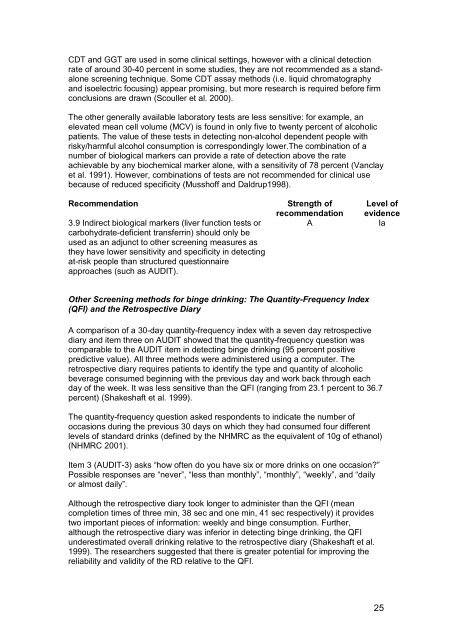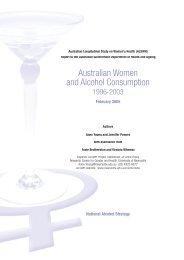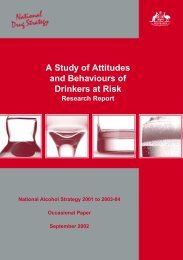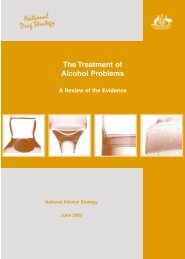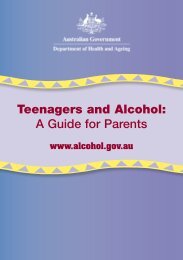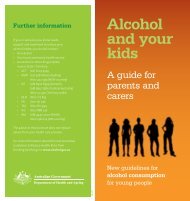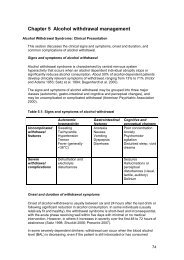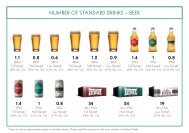Chapter 3 Screening, assessment and treatment planning - Alcohol
Chapter 3 Screening, assessment and treatment planning - Alcohol
Chapter 3 Screening, assessment and treatment planning - Alcohol
You also want an ePaper? Increase the reach of your titles
YUMPU automatically turns print PDFs into web optimized ePapers that Google loves.
CDT <strong>and</strong> GGT are used in some clinical settings, however with a clinical detectionrate of around 30-40 percent in some studies, they are not recommended as a st<strong>and</strong>alonescreening technique. Some CDT assay methods (i.e. liquid chromatography<strong>and</strong> isoelectric focusing) appear promising, but more research is required before firmconclusions are drawn (Scouller et al. 2000).The other generally available laboratory tests are less sensitive: for example, anelevated mean cell volume (MCV) is found in only five to twenty percent of alcoholicpatients. The value of these tests in detecting non-alcohol dependent people withrisky/harmful alcohol consumption is correspondingly lower.The combination of anumber of biological markers can provide a rate of detection above the rateachievable by any biochemical marker alone, with a sensitivity of 78 percent (Vanclayet al. 1991). However, combinations of tests are not recommended for clinical usebecause of reduced specificity (Musshoff <strong>and</strong> Daldrup1998).Recommendation3.9 Indirect biological markers (liver function tests orcarbohydrate-deficient transferrin) should only beused as an adjunct to other screening measures asthey have lower sensitivity <strong>and</strong> specificity in detectingat-risk people than structured questionnaireapproaches (such as AUDIT).Strength ofrecommendationALevel ofevidenceIaOther <strong>Screening</strong> methods for binge drinking: The Quantity-Frequency Index(QFI) <strong>and</strong> the Retrospective DiaryA comparison of a 30-day quantity-frequency index with a seven day retrospectivediary <strong>and</strong> item three on AUDIT showed that the quantity-frequency question wascomparable to the AUDIT item in detecting binge drinking (95 percent positivepredictive value). All three methods were administered using a computer. Theretrospective diary requires patients to identify the type <strong>and</strong> quantity of alcoholicbeverage consumed beginning with the previous day <strong>and</strong> work back through eachday of the week. It was less sensitive than the QFI (ranging from 23.1 percent to 36.7percent) (Shakeshaft et al. 1999).The quantity-frequency question asked respondents to indicate the number ofoccasions during the previous 30 days on which they had consumed four differentlevels of st<strong>and</strong>ard drinks (defined by the NHMRC as the equivalent of 10g of ethanol)(NHMRC 2001).Item 3 (AUDIT-3) asks “how often do you have six or more drinks on one occasion?”Possible responses are “never”, “less than monthly”, “monthly”, “weekly”, <strong>and</strong> “dailyor almost daily”.Although the retrospective diary took longer to administer than the QFI (meancompletion times of three min, 38 sec <strong>and</strong> one min, 41 sec respectively) it providestwo important pieces of information: weekly <strong>and</strong> binge consumption. Further,although the retrospective diary was inferior in detecting binge drinking, the QFIunderestimated overall drinking relative to the retrospective diary (Shakeshaft et al.1999). The researchers suggested that there is greater potential for improving thereliability <strong>and</strong> validity of the RD relative to the QFI.25


